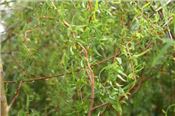Grow Curly Willows For An Artistic Twist In The Landscape, Winter Flower Arrangements

The unique branching and twisting features of the Salix genus curly willow not only adds visual interest to the winter
landscape but it can also be harvested and used for unique decorative arrangements.
Photo by David J. Stang.
CHRISTINA LUEKING
URBANA, ILLINOIS
Willow trees are most well known for their long, draping branches that give them a refined and graceful appearance. That is unless it is a corkscrew willow.
The unique branching and twisting features of the Salix genus curly willow not only adds visual interest to the winter landscape but it can also be harvested and used for unique decorative arrangements says University of Illinois Extension horticulture educator Christina Lueking.
“Curly willow has beautifully curled branches that have led to some crazy common names such as corkscrew willow, twisted willow, and snake willow,” Lueking says.
Woody varieties generally prefer fertile, well-drained soil and full sun throughout the day. However, willows are a perfect fit for filter strips between annual crops or wet areas with their mature branches that are upright with a few sweeping younger branches that droop until they become more mature. These trees are easily propagated and can have a long lifespan as a sculptural element in the landscape or a garden bed.
The fall leaves turn a golden yellow color before dropping to show off the brilliantly colored burgundy or golden stems. Prune these stems to 3-foot-long sections and use the results in winter decorations.
“These sturdy bundles can be molded into round wreaths, heart-shaped designs, or even free flowing sculptures in vases with white lights,” Lueking says. “Have fun enhancing your décor or arrangements with this unique willow.”
Harvest of branches can range from a few feet on shrubs to several feet on mature trees. Branches can be used as a fresh or dry product in floral arrangements. Remember to mold stems while they are pliable and bundle them with wire before they dry. It is harder to shape stems if they are completely dried.
Pests that like to feed on the leaves of the willow are aphids, spider mites, mealy bugs, lace bugs, caterpillars, willow leaf beetles. The willow borer drills into the trunks and creates tunnels and the adults emerge to feed on the tissue of the branches.
Scout willows to spot infestations that can be controlled by pruning the heavily infested areas and disposing of the cuttings. The areas can then be sprayed with neem oil or insecticidal soap.
"Willow trees do have a couple of disease issues including crown gall and willow scab,” Leuking says. “But with scouting and mulching you can be proactive in controlling these issues.” ∆
CHRISTINA LUEKING: Horticulture Educator, University of Illinois